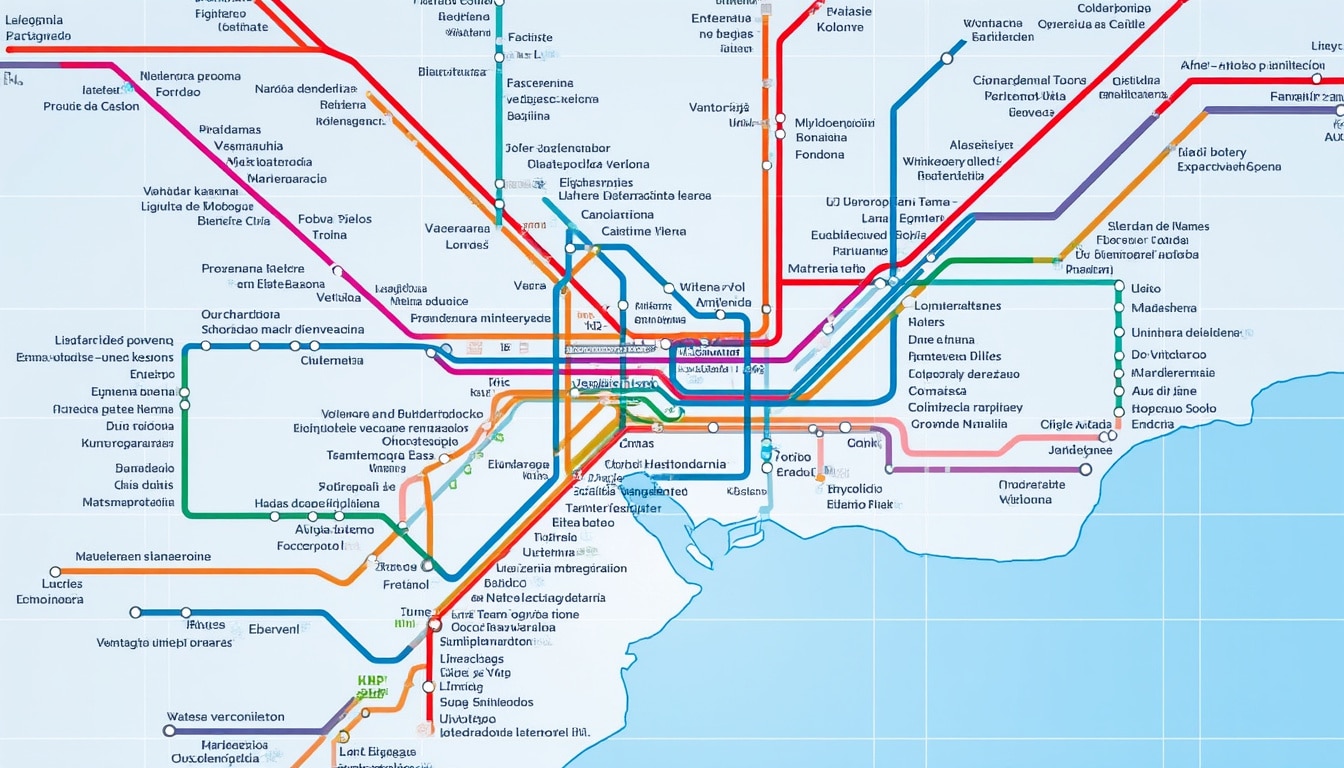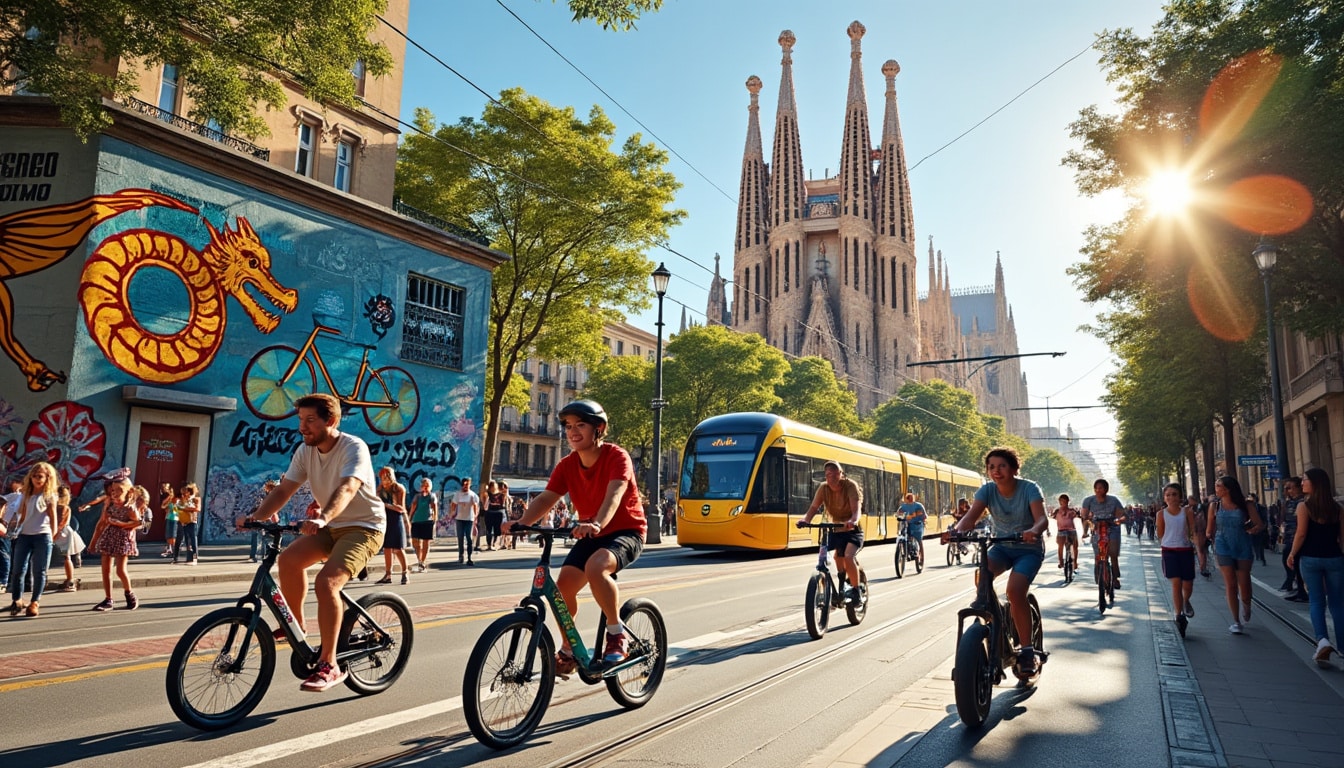Barcelona, a city renowned for its vibrant culture, stunning architecture, and Mediterranean charm, is also a hub of efficient and diverse transportation options. Navigating its bustling streets and picturesque avenues has never been more convenient, thanks to an expansive network of public and private transportation modes. Whether a resident or a traveller, understanding how to seamlessly move across the city is crucial in fully experiencing what Barcelona has to offer. From the reliable metro system and comprehensive bus routes to bike-sharing programs and high-speed trains, every corner of this Spanish gem is accessible.
The Extensive Public Transport Network in Barcelona
In Barcelona, the public transportation network is a testament to the city’s commitment to convenience and accessibility. Spearheaded by the Transports Metropolitans de Barcelona (TMB), the network boasts an extensive metro system, an intricate web of buses, and efficient commuter trains. The metro, with its distinctive color-coded lines, connects major neighborhoods and attractions, making it an indispensable mode of transport for both locals and tourists. Indeed, the metro system is one of the cleanest and most reliable in all of Europe, with stations rarely more than a ten-minute walk away, providing easy access to iconic sites like Sagrada Família and Park Güell.
Buses in Barcelona cover over a hundred routes, connecting districts efficiently. Notably, these buses are equipped for those with reduced mobility, offering a level of inclusivity that enhances the city’s appeal. The TMB also operates the night bus service, perfect for those who explore the city until the wee hours. Running from 10 pm to 5 am, night buses ensure that Barcelona remains lively around the clock.

Beyond local transport, the city is adeptly connected to the surrounding region through Renfe trains and the Ferrocarrils de la Generalitat de Catalunya (FGC). The FGC serves not only as a commuter rail but also manages a section of the metro, providing seamless transitions between city and suburb. For many, the transport system is integrated with digital conveniences such as the T-mobilitat card, which allows travelers to easily switch between different transport modes without the hassle of managing multiple tickets. This integrated system is a saving grace for frequent travelers, offering flexible tickets like the T-Casual, which is ideal for both extended stays and quick visits.
The Role of TMB in Enhancing Mobility
The TMB plays a vital role in enhancing mobility throughout the city. With innovative services and a dedication to improvement, it ensures Barcelona stays ahead in urban transportation. Metro services are frequent, especially during peak hours, and the strategic placement of stations facilitates easy transfers between different lines. This is particularly beneficial for tourists and newcomers who may find navigating public transport systems intimidating. Furthermore, information is readily available in multiple languages, ensuring non-Spanish speakers can traverse the city without linguistic barriers, reflecting the global nature of Barcelona.
Understanding the operators and their logos can be incredibly beneficial for new users. Metro lines, for instance, are marked with an ‘L’ followed by a color and number, like L1 or L3, to simplify navigation. The tram lines are similarly marked, helping passengers quickly identify their modes of transport.
Innovative Transport Solutions: Bicycles and Electric Scooters
Barcelona is at the forefront of promoting sustainable and eco-friendly modes of transport. Bicycles and electric scooters are increasingly popular among residents, and the city has made substantial investments in infrastructure to support this eco-friendly trend. With dedicated lanes and bike parking areas, cyclists can navigate the city safely and enjoyably. Proponents of sustainable transport argue that it reduces congestion and pollution while promoting a healthier lifestyle.
The city is home to Bicing, a bike-sharing program tailored for residents that offers a yearly membership with numerous benefits. Although primarily for locals, it demonstrates the city’s commitment to integrating cycling into daily life. Several companies offer rental services for tourists, providing easy access to bicycles and e-bikes.
For those new to the concept, electric scooters are another transport alternative gaining traction. While not allowed on public transport, they can be used in many areas of the city, offering a flexible and cost-effective mode of travel. Much like bikes, scooter rentals are widely available, further supporting the environmental initiatives endorsed by the city. Riding a scooter or bike allows for a more immersive experience of Barcelona’s vibrant neighborhoods and scenic vistas.
Barcelona’s emphasis on sustainable transport also reflects its ambition to reduce carbon emissions significantly. The local government continues to expand bike paths and pedestrian-friendly zones, encouraging a shift from traditional vehicles to cleaner alternatives. The growing availability of electric bike options within the bike-sharing program, such as AMBici, highlights this dedication. With affordable yearly plans, they provide a practical solution for both day-to-day commutes and leisurely explorations.
Electric Scooters: Rules and Regulations
The adoption of electric scooters comes with its own set of rules. Riders must wear helmets and are prohibited from using sidewalks unless designated lanes exist. This ensures pedestrian safety while allowing riders to navigate the city efficiently. Additionally, the regulation helps maintain order and protect foot traffic from potential accidents. As the trend grows, it is expected that further infrastructure development will support and enhance the integration of scooters into Barcelona’s overall transport system.
Barcelona is a trailblazer in blending traditional and modern transport methods, offering diverse, sustainable, and efficient options to meet the needs of residents and visitors alike. Whether commuting for work or exploring the city’s historic landmarks, these innovative solutions contribute to a seamless mobility experience.
Efficient and Reliable: Using Taxis and Ride-Sharing Apps
Taxis in Barcelona, instantly recognizable by their yellow and black colors, offer another reliable mode of transport. With over 300 taxi ranks spread across the city, finding a ride when needed is never an issue. Taxi Barcelona services ensure that passengers can reach their destination promptly and safely. Fares are metered, with additional surcharges applicable for luggage or airport trips. These taxis benefit from advanced GPS systems ensuring accurate fare calculation and efficient routing.
For those preferring app-based services, Cabify and Uber offer competitive alternatives. These platforms allow travelers to book rides easily via mobile, often with detailed fare estimates provided upfront. Users can select preferred vehicle types and enjoy cashless transactions for an added layer of convenience. It’s important to note that, while Uber is available, traditional taxi services tend to be more prevalent and are often encouraged for quick pickups. Glovo, known for delivery services, offers express rides within the city too, catering to time-sensitive commutes.
Choosing between taxis or ride-sharing services often comes down to personal preference or situational needs. For language-conscious travelers, ride-sharing apps provide a straightforward option with interfaces available in multiple languages. Additionally, these apps can potentially mitigate the uncertainty some visitors may feel about navigating a new city’s transport landscape.
Tips for Using Taxis and Rideshare Apps
- 🚖 Always check that the meter is running and corresponds with the displayed fare rates.
- 🤳 Use apps like Cabify and Uber for fare transparency and convenience.
- 💬 For taxis, it can be helpful to know basic Spanish phrases to communicate destinations.
- 🗺️ Consult maps through the ride-sharing app to ensure the most efficient route.
The ride-sharing landscape in Barcelona is poised for growth, driven by technological advancements and changing consumer preferences. In the coming years, ride-sharing is likely to become even more integral to Barcelona’s transport ecosystem, providing customized travel experiences tailored to individual needs.
Reaching Beyond the City: Barcelona’s Connection to Nearby Regions
Barcelona serves as a gateway not only to the surrounding Catalonian countryside but also to major Spanish and European cities. Its strategically important location means that efficient transportation extends beyond the urban center, forging crucial connections with the broader region. Renfe spearheads long-distance and high-speed services, offering quick journeys to Madrid, Valencia, and beyond. With travel times that dramatically reduce compared to traditional options, these AVE trains are a traveler’s dream when scheduling day trips or longer excursions.
For regional travel, the Rodalies and FGC services present excellent choices. They facilitate travel to suburban areas and other Catalonian municipalities, creating an interconnected network that expands commuting possibilities for residents and visitors alike. Meanwhile, the high-speed network accessible from Barcelona Sants station links travelers to destinations like Paris, offering a compelling alternative to air travel.
Tickets for these services can be effortlessly purchased online via platforms like Renfe’s official site or through third-party booking services. Maintaining a flexible itinerary becomes easy, with various pricing tiers and advanced booking options, ensuring that budgetary considerations can be managed effectively. Passengers seeking an upgraded travel experience can opt for first-class tickets, which include added amenities like more spacious seating and premium service.
High-Speed Rail: A Gateway to Adventure
- 🚅 Enjoy reduced travel times to cities across Spain and Europe on AVE trains.
- 🎟️ Purchase tickets in advance to secure the best fares and desired travel times.
- 🧳 Consider utilizing high-speed rail for day trips to maximize exploration time.
Ultimately, Barcelona’s robust transport infrastructure ensures seamless connectivity within and beyond the city limits. The city’s strategic investment in high-speed rail and commuter services affirms its commitment to accessibility and convenience, making it a pivotal point in both national and international travel plans.
Integrated Payment Systems: Simplifying Transport in Barcelona
Streamlined ticketing and payment systems are at the core of Barcelona’s efficient transport network. The introduction of T-mobilitat, a digital card system, has simplified the process of accessing multiple transport services. The all-in-one card allows passengers to use buses, metro, tram, and trains without worrying about purchasing separate tickets for each trip. This level of integration eliminates the hassle of handling multiple tickets and enhances the convenience of city travel.
For tourists, options like the Hola Barcelona Travel Card cater specifically to varying lengths of stay, offering unlimited travel for set durations. Tourists can purchase these cards at various points throughout the city, including major transport hubs. These cards are particularly useful for those planning extensive exploration, as they offer great savings over standard fare rates.
Moreover, digital payment methods reign supreme, with contactless transactions made easy across most transport services. Whether utilizing credit cards, mobile payment platforms, or integrated passes like the T-mobilitat, passengers can navigate Barcelona’s transport landscape with ease and efficiency. In addition, platforms like Barcelona Panorama provide detailed resources on payment systems and transport tips, aiding newcomers in optimizing their travel experiences.
Improving the Travel Experience with Integrated Systems
- 🪙 Utilize T-mobilitat for seamless access to multiple transport modes.
- 📆 Plan longer stays with Hola Barcelona cards for unlimited travel benefits.
- 💳 Leverage digital payments for ease and security during transit.
Barcelona’s commitment to this efficient and user-friendly ticketing system underscores its dedication to enhancing the overall travel experience. As technology evolves, the city’s transportation network is expected to see continued improvements, providing even greater mobility solutions for residents and visitors in the coming years.
FAQs about Transportation in Barcelona
What is the most efficient way to navigate public transport in Barcelona?
The most efficient way is by using the T-mobilitat card, which allows access across all transport services such as metro, buses, trams, and rail networks.
Are bicycles a practical mode of transport in the city?
Yes, Barcelona is a bicycle-friendly city with extensive bike lanes and parking facilities, making it practical for both commuting and sightseeing.
How does the T-mobilitat system work?
The T-mobilitat system works as a digital card, providing access to all integrated transport services in Barcelona. It can be purchased and managed digitally, simplifying travel across different modes.
Can I use ride-sharing apps like Uber in Barcelona?
While Uber is available, using traditional taxis or competing apps like Cabify is often more efficient for quick pickups in the city.
What are the benefits of high-speed trains from Barcelona?
High-speed trains offer quick connections to major Spanish and European cities, providing an excellent travel alternative to flying.

